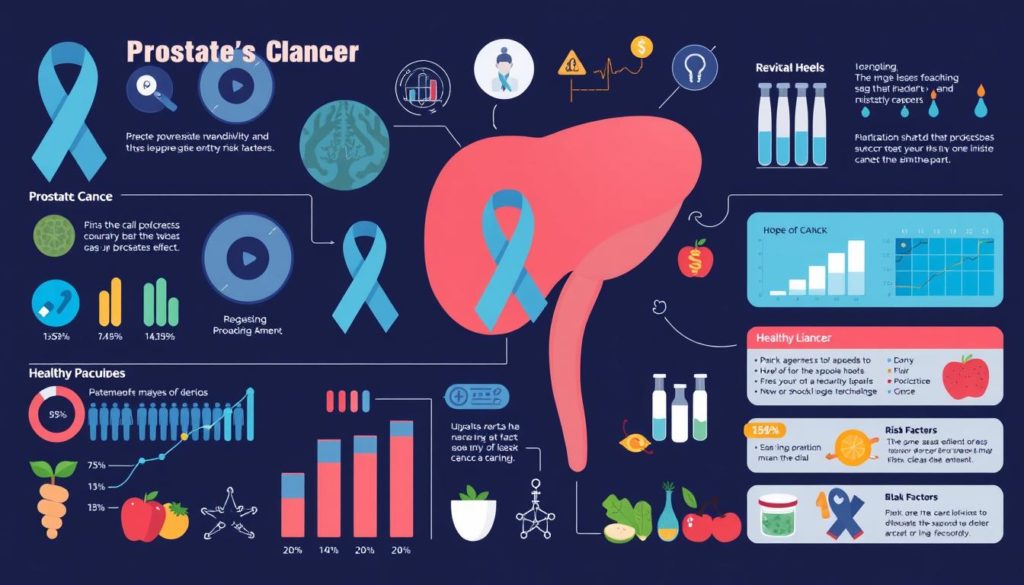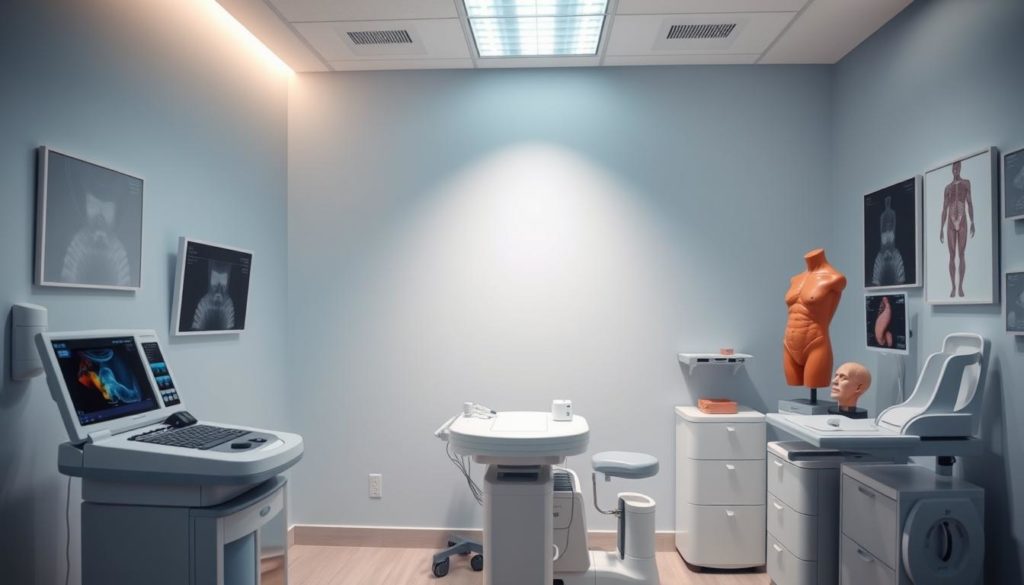Did you know that nearly 1 in 9 men will get prostate cancer in their life? This fact shows why it’s vital to know how to manage prostate cancer. An effective care plan can greatly help patients.
Esteemed urologist Dr. Mitchell Humphreys from Mayo Clinic will lead us through new advancements. He’ll cover early detection and comprehensive guidance to cutting-edge treatments. We’ll learn how to best help patients on their journey.
Join us as we dive into the complexities of prostate cancer care. We’ll discover strategies that truly make a difference.
Understanding Prostate Cancer: Basic Facts
Prostate cancer starts in the prostate gland of men. This gland is key to the male reproductive system, helping create semen.

What is Prostate Cancer?
Cancer cells grow out of control in the prostate gland. These cells can then spread to other body parts. Knowing your prostate cancer treatment options early can make a big difference.
Common Symptoms of Prostate Cancer
The signs of prostate cancer may seem like other conditions such as benign prostatic hyperplasia (BPH). Symptoms include:
- Difficulty starting urination
- A weak or interrupted urinary stream
- Frequent urination, especially at night
- Discomfort in the pelvic area
Spotting these symptoms early is key to finding the right prostate cancer treatment options.
Risk Factors for Prostate Cancer
Some prostate cancer risk factors boost chances of getting the disease:
- Age: Risk increases for men above 50.
- Race: African-American men have a higher risk.
- Family History: Risk goes up with family history.
- Lifestyle Choices: Diet and exercise can influence risk.
Screenings and a healthy lifestyle can cut down prostate cancer risk factors. Dr. Humphreys notes eating well and exercising can help prevent it.
| Risk Factor | Details | Preventive Measures |
|---|---|---|
| Age | Men over 50 years | Regular screening after 50 |
| Race | African-American men | Discuss risk factors with a healthcare provider |
| Family History | Genetic predisposition to prostate cancer | Annual health check-ups |
| Lifestyle Choices | Poor diet, lack of exercise | Embrace a heart-healthy diet and regular exercise |
Diagnosis of Prostate Cancer
Finding prostate cancer early is key to figuring out the best treatment. There are several methods to detect and confirm prostate cancer. Each plays a role in the diagnosis process.
Screening Methods
Screening for prostate cancer usually involves a digital rectal exam (DRE) and a PSA test. A blood test measures the PSA level. A higher level might mean more tests are needed. Though there’s debate about the benefits and risks of screening, more tests like ultrasounds or MRIs can be suggested.

Prostate Biopsy Explained
To confirm prostate cancer, a biopsy is needed. In this procedure, doctors take tissue samples from the prostate to look for cancer cells. This confirms cancer and shows how much it has spread.
Common biopsy methods include:
- Transrectal ultrasound-guided biopsy
- MRI-TRUS fusion biopsy
- Transperineal biopsy
The Gleason Score: Assessing Cancer Aggressiveness
After a biopsy confirms cancer, doctors find out the Gleason score. This score, from 6 to 10, shows how aggressive the cancer is. It helps predict how the cancer will act and plan treatment. Genomic testing also gives more information on the tumor.
| Gleason Score | Grade Group | Interpretation |
|---|---|---|
| 6 | 1 | Low risk |
| 7 (3+4) | 2 | Intermediate risk |
| 7 (4+3) | 3 | Intermediate risk |
| 8 | 4 | High risk |
| 9-10 | 5 | Very high risk |
By using PSA levels, the Gleason score, and genomic testing, doctors can classify prostate cancer. They can make a treatment plan that’s right for the individual.
Prostate Cancer Staging and Its Importance
Understanding prostate cancer staging is key to find the right treatments. Staging shows how far the cancer has spread. It ranges from stage I, for less advanced disease, to stage IV, where cancer has spread far. Knowing the stage helps doctors plan treatment and predict outcomes.
Stages of Prostate Cancer
The stages of prostate cancer depend on prostate-specific antigen (PSA) levels, the Gleason score, and Grade Grouping. Let’s review the stages:
- Stage I: Cancer is only in the prostate, with a Gleason score (≤6) and low PSA.
- Stage II: It’s still in the prostate but more aggressive. Gleason scores are 7 to 8, and PSA levels are 10-20.
- Stage III: Cancer has moved to nearby tissues. Gleason scores are 8 or higher, and PSA is over 20.
- Stage IV: It has reached other parts like lymph nodes or bones. This is the most aggressive stage, needing detailed treatment plans.
Diagnostic Tests Used in Staging
Various prostate cancer diagnostic tests are crucial in staging. They include:
- PSA Blood Test: This checks for prostate-specific antigen in the blood.
- Gleason Score: Looks at prostate tissue under a microscope to judge cancer’s aggressiveness.
- Bone Scan: Finds if cancer has reached the bones.
- CT Scan and MRI: These scans give clear pictures of the prostate and nearby areas.
- PET Scan: Identifies where cancer cells are in the body.
Knowing the stage of prostate cancer is vital. It helps in fighting cancer growth and choosing the right therapies. These diagnostic tests give a full picture, helping doctors make the best treatment choices.
| Stage | Description | Diagnostic Tests |
|---|---|---|
| I | Localized, low-grade cancer within prostate | PSA, Gleason Score |
| II | Localized cancer showing more aggression | PSA, Gleason Score, MRI |
| III | Cancer extending beyond prostate | PSA, Gleason Score, CT Scan |
| IV | Metastasized cancer | PSA, Gleason Score, PET Scan |
Prostate Cancer Management Strategies
Personalized prostate cancer care is paramount in creating an effective prostate cancer care plan. Every case is unique, requiring a detailed approach. This ensures the treatment matches the individual’s needs. Here, we will explore different strategies, ranging from watchful waiting to cutting-edge treatments.
When making a care plan, doctors consider many factors. These include the cancer’s stage, how quickly it is growing, and the patient’s health. The goal is to fight cancer while improving the patient’s life quality.
Creating an effective treatment plan involves multiple steps:
- Active Surveillance – Best for cancer that grows slowly, where monitoring is chosen over immediate treatment.
- Radiation Therapy – Uses targeted radiation to kill cancer cells but saves healthy ones.
- Surgical Options – Surgeries that are less invasive help patients recover faster and show better results.
- Hormone Therapy – Adjusts hormone levels to reduce cancer growth.
- Innovative Treatments – New therapies and trials provide options for tough cases.
To manage prostate cancer well, the strategy must be all-encompassing. A plan that includes these various treatments is crucial. This ensures every patient receives care that’s tailor-made for them.
Active Surveillance: Watchful Waiting
Watchful waiting, or active surveillance, is a careful way to manage prostate cancer that’s not aggressive. Doctors keep a close eye on the cancer but don’t treat it right away.
When is Active Surveillance Appropriate?
This method works best for men with prostate cancer that grows slowly. It’s often chosen by patients who are expected to live less than 10 years. For them, the cancer likely won’t cause major issues in their lifetime.
Monitoring Methods
To watch the cancer, doctors will do regular blood tests, rectal exams, and biopsies.
- PSA (Prostate-Specific Antigen) tests
- Digital rectal exams (DRE)
- Prostate biopsies
Advantages and Limitations
Choosing active surveillance has big benefits. It helps avoid unnecessary treatments and keeps the patient’s life quality high.
- It cuts down on treatment side effects.
- It spots changes in the cancer early on.
But, there are drawbacks. Patients must visit the doctor often. And, they might feel anxious about their cancer.
Surgical Options for Prostate Cancer
When diagnosed with prostate cancer, surgery is a key way to fight it. Different surgeries are available, based on the patient’s cancer stage and condition.
Radical Prostatectomy
One common surgery is radical prostatectomy. This means totally removing the prostate and nearby tissues. It’s mainly for cancer that hasn’t spread and is a strong first step. The Mayo Clinic sees it as a good option for people in the intermediate-risk group.
Minimally Invasive Surgery
Less invasive surgeries are also an option. These include techniques like laparoscopic and robotic-assisted surgeries. They come with benefits like smaller cuts, which may lead to quicker recovery and fewer complications.
For more on these surgeries, see Mayo Clinic’s insights on prostate cancer.
Risks and Benefits of Surgery
Surgery for prostate cancer has risks and benefits. Both radical and less invasive surgeries work well against cancer. However, they could cause issues like incontinence and erectile dysfunction. It’s vital to weigh these risks against the possible good outcomes, such as better prognosis and possible cure.
- Benefits:
- Effectively removes cancer
- Can lead to long-term remission
- Less recovery time with less invasive methods
- Risks:
- Incontinence
- Erectile dysfunction
- Possible surgical complications
Talking in detail with their medical team helps patients make the best choice for their health and cancer stage. Getting personalized care and keeping open communication are key for the best results.
Radiation Therapy for Prostate Cancer
Radiation therapy is a top choice for treating prostate cancer. It has different methods that fit patient needs. Each option affects patients in unique ways.
Types of Radiation Therapy
Prostate cancer radiation therapy comes in two main forms:
- External Beam Radiation Therapy (EBRT): This approach uses high-energy rays from outside the body. It targets cancer in the prostate. EBRT takes several weeks. It aims to protect nearby tissues.
- Brachytherapy: Known as internal radiation, this method puts radioactive seeds in the prostate. It targets cancer with a high radiation dose, but spares healthy tissues. Brachytherapy comes as either low-dose-rate (LDR) or high-dose-rate (HDR) therapy.
Side Effects and Management
Patients may face different side effects from radiation therapy. These side effects can range in how severe they are. Common ones include:
- Fatigue
- Skin irritation where treated
- Urinary issues like more frequent needs or discomfort
- Gastrointestinal problems such as diarrhea or rectal bleeding
- Problems with sexual function
Doctors often recommend several ways to handle these side effects. These can include:
- Medication for urinary and stomach troubles
- Diet help to fight fatigue and keep strength up
- Help for sexual health issues
- Regular check-ups to deal with any new problems
The choice between EBRT and brachytherapy factors in cancer stage, overall health, and patient preference. Working closely with doctors ensures patients get the best, personalized care.
| Type of Therapy | Key Features | Common Side Effects |
|---|---|---|
| External Beam Radiation Therapy | Non-invasive, targets precisely | Fatigue, skin irritation, urinary problems |
| Brachytherapy | Internal, high-dose targeting | Discomfort in urinary, stomach issues |
Hormone Therapy in Prostate Cancer Treatment
Hormone therapy, also known as androgen deprivation therapy, plays a major role in prostate cancer treatment. It lowers the levels of male hormones, or androgens. This helps slow the growth of cancer cells. It’s crucial for managing advanced prostate cancer.
How Hormone Therapy Works
Hormone therapy targets prostate cancer by reducing or blocking the body’s androgens. It can be done through surgery or medication. Medications are LHRH agonists and antagonists. They reduce androgen levels, slowing the cancer. Often, it’s combined with other treatments, like radiation, for better results.
Who Are the Candidates?
Patients with advanced stages of prostate cancer, especially stage IVA and IVB, might need hormone therapy. It’s also for those whose cancer has spread to lymph nodes or bones. High-risk patients often receive it with radiation therapy to improve outcomes. For more details, visit the American Cancer Society’s website. This is a key therapy for advanced prostate cancer, offering hope to many.
Advanced Prostate Cancer Therapies
For advanced prostate cancer cases, we explore cutting-edge treatments beyond traditional methods. These involve precision medicines and new technologies aimed at the cancer’s core. They offer fresh hope in managing, or even beating, late-stage disease.
Innovative and Experimental Treatments
New treatments for prostate cancer are changing cancer care. Targeted therapies attack cancer’s growth on a cellular level. Meanwhile, immunotherapies boost the body’s own defenses to fight cancer. These new approaches are expanding what’s possible in treatment.
Clinical Trials and Latest Developments
Clinical trials are crucial for testing new prostate cancer treatments. They give patients access to cutting-edge therapies not yet available to everyone. By participating, patients help advance cancer treatment, offering hope to future generations.
FAQ
What is Prostate Cancer?
Prostate cancer starts in the prostate gland tissue. It is part of the male reproductive system and makes some semen components.
What are common symptoms of prostate cancer?
Symptoms include trouble starting to pee, a weak stream, and peeing often. There’s also pain in the pelvic area.
If the cancer spreads, it can cause back pain and anemia symptoms.
What are the risk factors for prostate cancer?
Age, race, family background, and lifestyle choices are risk factors. Genetics can also make you more likely to get it.
But, prostate cancer does not spread through sex or biopsy.
What are the methods for screening prostate cancer?
Screening involves a digital rectal exam and a PSA blood test. Ultrasounds or MRIs may also be done.
The PSA test and PMASA PET scan can find cancer spreads.
How is prostate cancer confirmed?
A biopsy, where doctors check tissue for cancer cells, confirms it. The Gleason Score and genomic tests check its severity.
What is the Gleason Score in prostate cancer?
The Gleason Score grades the cancer’s aggressiveness from its look under a microscope. It guides treatment and predicts outcomes.
How is prostate cancer staged?
Staging shows how much the cancer has spread. It ranges from stage I to IV. This tells doctors the best treatment plan.
Bone scans, CT scans, MRIs, and PET scans are used for staging.
What does active surveillance in prostate cancer involve?
Active surveillance means watching low-grade, slow-growing cancer closely. It includes regular blood tests and biopsies, avoiding treatments when possible.
What are the surgical options for prostate cancer?
Radical prostatectomy removes the prostate and nearby tissues. There are also minimally invasive surgeries, like robotic ones. Surgery’s risks and benefits must be balanced.
What types of radiation therapy are used in prostate cancer?
Radiation therapy includes external beam radiation and brachytherapy. These can be used instead of, or along with, surgery. The choice depends on the cancer stage and what the patient wants.
How does hormone therapy work in treating prostate cancer?
Hormone therapy lowers male hormone levels to stop cancer growth. It’s for advanced cancer and can be combined with radiation or surgery.
What are the latest therapies for advanced prostate cancer?
New treatments target cancer’s molecular level. Clinical trials offer new targeted therapies and immunotherapies. These are cutting-edge options in managing prostate cancer.


